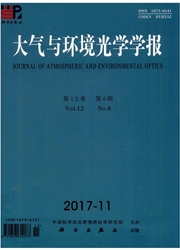

 中文摘要:
中文摘要:
利用两个AERONET站点(Hangzhou_ZFU、SACOL)的Level2AOD数据对比验证CALIOP Level2气溶胶光学厚度(aerosol optical depth,AOD)数据。结果表明:Hangzhou_ZFU、SACOL站的相关系数为0.87、0.85,回归方程的斜率为0.76、0.92,这表明CALIOPAOD与AERONETAOD显著相关,在这两个站点及附近区域具有适应性。基于2008~2015年无云条件下的CALIOP Level3月气溶胶产品和同期的MODIS Terra/AquaLevel 3月气溶胶产品,对比分析中国东南和西北区域气溶胶光学厚度(aerosol optical depth,AOD)时空分布特征。分析表明:中国东南区域AOD季节与空间变化明显,AOD高值主要分布在长三角、珠三角等地,且夏季最高、春季次之,秋冬季相当。MODIS AOD月均值保持在在0.25~0.8之间,且与CALIOP夜间AOD值接近,但与CALIOP白天AOD值差异较大,最大相差值可达0.45。中国西北区域两种卫星获取的AOD值空间分布非常相似,其高值区都位于塔里木盆地、准格尔盆地和柴达木盆地;AOD值春季最高,夏季减少、冬季次之、秋季最低;MODISAOD值波动显著且普遍高于CALIOPAOD值。
 英文摘要:
英文摘要:
Combining CALIOP aerosol optical depth (AOD) products and coincident AODs at two AERONET sites (i.e., Hangzhou_ ZFU and SACOL), CALIOP Level 2 column AOD against AERONET AOD is validated. Intercomparison analyses show that the correlation coefficient between AOD at Hangzhou_ZFU (SACOL) and CALIPSO-derived AOD reaches as high as 0.87 (0.85), and the slope of the regression equation is 0.76 (0.92), indicating that CALIOP AOD is better enough to be applied to characterize the regional air pollution. Based on concurrent CALIOP level 3 monthly mean gridded AOD products (daytime and nighttime) and the MODIS Terra/Aqua level 3 monthly mean AOD dataset of the 8 years (2008~2015), the spatial and temporal variations of AOD over Southeast China and Northwest China are analyzed. Results show that Southeast China exhibits a significant seasonal and spatial variability. High AOD values are largely located in Yangtze River Delta and Pearl River Delta. The highest AOD occurs in spring, followed by summer, and then winter and autumn. In terms of monthly average AOD, MODIS tends to overestimate AOD compared with AERONET, ranging from 0.25 to 0.8, CALIOP AOD during night is commensurate with MODIS AOD. By comparison, much difference exists between the daytime CALIPSO AOD and MODIS AOD, which is as high as 0.45. Results from both MODIS and CALIPSO AODs suggest that the spatial distribution of AOD is very similar. To be more specific, the high AOD value is largely located in the Tarim Basin, Junggar Basin and Qaidam Basin. Meanwhile, the highest AOD value occurs in the spring, followed by summer, then winter and autumn. Overall, MODIS AOD values fluctuate significantly and are generally higher than CALIOP AOD values.
 同期刊论文项目
同期刊论文项目
 同项目期刊论文
同项目期刊论文
 期刊信息
期刊信息
